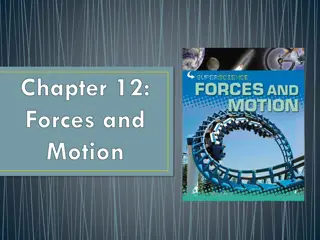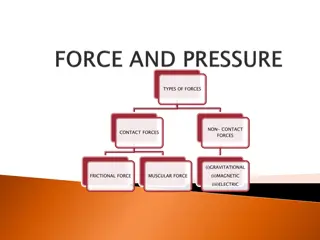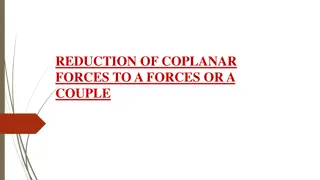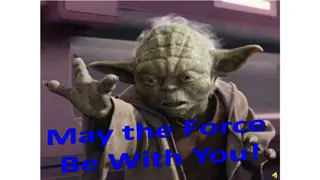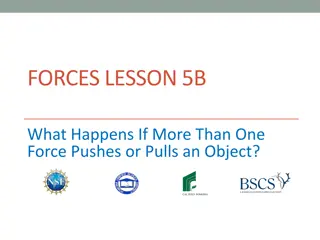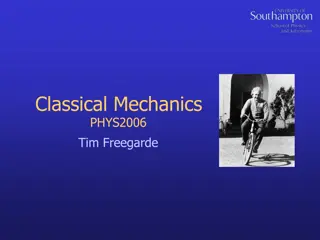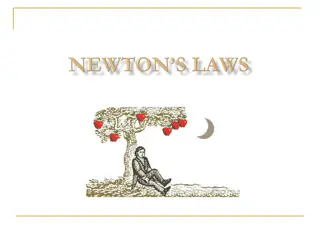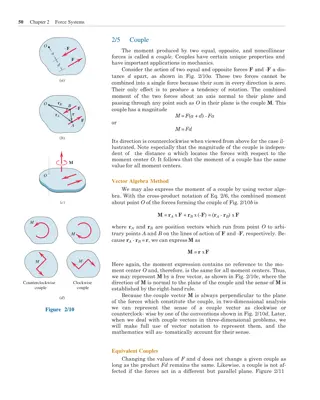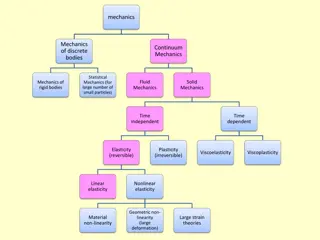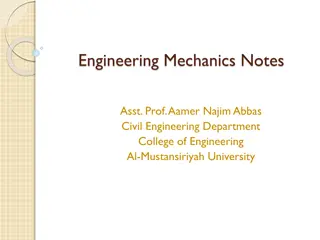Understanding Forces in Mechanics: Fundamentals and Applications
Prof. Madhuri Reddy, an Assistant Professor at Hope Foundation's International Institute of Information Technology, explains the characteristics of forces, systems of forces, and the concept of resultant force and composition of forces in mechanics. Forces are defined as agents that produce or destroy motion, and their effects can change the motion of a body, bring it to rest, or create internal stresses. The magnitude, direction, nature, and point of application are key characteristics of a force. Different types of forces in systems, such as coplanar and concurrent forces, play crucial roles in analyzing mechanical systems.
Download Presentation

Please find below an Image/Link to download the presentation.
The content on the website is provided AS IS for your information and personal use only. It may not be sold, licensed, or shared on other websites without obtaining consent from the author. Download presentation by click this link. If you encounter any issues during the download, it is possible that the publisher has removed the file from their server.
E N D
Presentation Transcript
Prof. Madhuri Reddy Assistant Professor Department of Applied Sciences & Engineering Hope Foundation s International Institute of Information Technology, I IT
INTRODUCTION Force:Defined as an agent which produces or tends to produce, destroys or tends to destroy motion. Effects Of A Force It may change the motion of a body. i.e. if a body is at rest, the force may set it in motion. It may retard the motion of a body. It may retard the forces, already acting on a body, thus bringing it to rest or in equilibrium. It may give rise to the internal stresses in the body, on which it acts. Hope Foundation s International Institute of Information Technology, I IT P-14,Rajiv Gandhi Infotech Park MIDC Phase 1, Hinjawadi, Pune 411057 Tel - +91 20 22933441/2/3 | www.isquareit.edu.in | info@isquareit.edu.in 2
CHARACTERISTICS OF A FORCE 1. Magnitude of the force 2. The direction of the line, along which the force acts It is also known as line of action of the force. 3. Nature of the force (i.e., whether the force is push or pull). 4. The point at which (or through which) the force acts on the body. Hope Foundation s International Institute of Information Technology, I IT P-14,Rajiv Gandhi Infotech Park MIDC Phase 1, Hinjawadi, Pune 411057 Tel - +91 20 22933441/2/3 | www.isquareit.edu.in | info@isquareit.edu.in 3
SYSTEM OF FORCES When two or more forces act on a body, they are called to form a system of forces. Coplanar forces. The forces, whose lines of action lie on the same plane. Collinear forces. The forces, whose lines of action lie on the same line. Concurrent forces. The forces, which meet at one point, are known as concurrent forces. Hope Foundation s International Institute of Information Technology, I IT P-14,Rajiv Gandhi Infotech Park MIDC Phase 1, Hinjawadi, Pune 411057 Tel - +91 20 22933441/2/3 | www.isquareit.edu.in | info@isquareit.edu.in 4
SYSTEM OF FORCES Coplanar concurrent forces. The forces, which meet at one point and their lines of action also lie on the same plane. Coplanar non-concurrent forces. The forces, which do not meet at one point, but theirlines of action lie on the same plane, are known as coplanar non-concurrent forces. Non-coplanar concurrent forces. The forces, which meet at one point, but their lines of action do not lie on the same plane. Non-coplanar non-concurrent forces. The forces, which do not meet at one point and their lines of action do not lie on the same plane Hope Foundation s International Institute of Information Technology, I IT P-14,Rajiv Gandhi Infotech Park MIDC Phase 1, Hinjawadi, Pune 411057 Tel - +91 20 22933441/2/3 | www.isquareit.edu.in | info@isquareit.edu.in 5
RESULTANT FORCE &COMPOSITION OF FORCES RESULTANT FORCE When number of forces are acting simultaneously on a particle, then it is possible to find out a single force which could replace them i.e., which would produce the same effect as produced by all the given forces. This single force is called resultant force COMPOSITION OF FORCES The process of finding out the resultant force, of a number of given forces, is called composition of forces or compounding of forces. Hope Foundation s International Institute of Information Technology, I IT P-14,Rajiv Gandhi Infotech Park MIDC Phase 1, Hinjawadi, Pune 411057 Tel - +91 20 22933441/2/3 | www.isquareit.edu.in | info@isquareit.edu.in 6
ANALYTICAL METHOD FOR RESULTANT FORCE PARALLELOGRAM LAW OF FORCES It states, If two forces, acting simultaneously on a particle,be represented in magnitude and direction by the two adjacent sides of a parallelogram ; their resultant may be represented in magnitude and direction by the diagonal of the parallelogram, which passes through their point of intersection. Mathematically, resultant force, R = F1 + F2 + 2F1F2 cos and Tan = F2 sin F1+F2cos where F1 and F2 = Forces whose resultant is required to be found out, = Angle between the forces F1 and F2, and = Angle which the resultant force makes with one of the forces (say F1). Hope Foundation s International Institute of Information Technology, I IT P-14,Rajiv Gandhi Infotech Park MIDC Phase 1, Hinjawadi, Pune 411057 Tel - +91 20 22933441/2/3 | www.isquareit.edu.in | info@isquareit.edu.in 7
METHOD OF RESOLUTION FOR THE RESULTANT FORCE Resolve all the forces horizontally and find the algebraic sum of all the horizontal components (i.e., H). Resolve all the forces vertically and find the algebraic sum of all the vertical components (i.e., V). The resultant R of the given forces will be given by the equation : R = ( H) + ( V ) The resultant force will be inclined at an angle , with the horizontal, such that tan = V H Hope Foundation s International Institute of Information Technology, I IT P-14,Rajiv Gandhi Infotech Park MIDC Phase 1, Hinjawadi, Pune 411057 Tel - +91 20 22933441/2/3 | www.isquareit.edu.in | info@isquareit.edu.in 8
EXERCISE 1. Find the resultant of two forces equal to 50 N and 30 N acting at an angle of 60 .[Ans. 70 N ; 21.8 ] 2. Two forces of 80 N and 70 N act simultaneously at a point. Find the resultant force, if the angle between them is 150 . [Ans. 106.3 N ; 61 ] 3. Find the resultant of two forces 130 N and 110 N respectively, acting at an angle whose tangent is 12/5. [Ans. 185.7 N ; 30.5 ] 4. A push of 180 N and pull of 350 N act simultaneously at a point. Find the resultant of the forces, if the angle between them be 135 . [Ans. 494 N ; 30 ] 5. Find the angle between two equal forces P, when their resultant is equal to (i) P and (ii) P/2. [Ans. 120 N ; 151 ] Hope Foundation s International Institute of Information Technology, I IT P-14,Rajiv Gandhi Infotech Park MIDC Phase 1, Hinjawadi, Pune 411057 Tel - +91 20 22933441/2/3 | www.isquareit.edu.in | info@isquareit.edu.in 9
Acknowledgements A Textbook of Engineering Mechanics By R S.Khurmi Engineering Mechanics by Dr. R K.Bansal 10
Thank You For further details, please contact Madhuri Reddy madhurir@isquareit.edu.in Department of Applied Sciences & Engineering Hope Foundation s International Institute of Information Technology, I IT P-14,Rajiv Gandhi Infotech Park MIDC Phase 1, Hinjawadi, Pune 411057 Tel - +91 20 22933441/2/3 www.isquareit.edu.in | info@isquareit.edu.in


